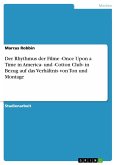Essay from the year 2008 in the subject Film Science, grade: 1,0, Humboldt-University of Berlin (Anglistik / Amerikanistik), course: Postmodern Cinema, language: English, abstract: David Fincher's movie Fight Club (1999)1 provoked a lot of debates because of its explicit depictions of violence, the representation of a mental disease, called Dissociative Identity Disorder (DID), and its questioning of today's masculine role. The latter is a very interesting theme to which I will dedicate this essay. In the following, I will show and analyze the representation of the feminized, post-masculine men in Fight Club. Firstly, I will concern myself with the causes of this emasculation. Directionless and without any real-life role-models or strong father figure, without any wars or enemies, men in Fight Club are drawn to consumer society to find a new focus in their lives. But consumerism feminizes men's bodies and pushes them more and more into a female sphere. Secondly, the effects of this feminization will be analyzed. Men want to re-masculinize their bodies and try to achieve this through a traditionally masculine way: violence. But even aggressive behaviour does not rescue them from their feminized self, as deriving pleasure from a fight involves both parts a sadistic, male and a masochistic, feminine one.
Dieser Download kann aus rechtlichen Gründen nur mit Rechnungsadresse in A, B, BG, CY, CZ, D, DK, EW, E, FIN, F, GR, HR, H, IRL, I, LT, L, LR, M, NL, PL, P, R, S, SLO, SK ausgeliefert werden.









